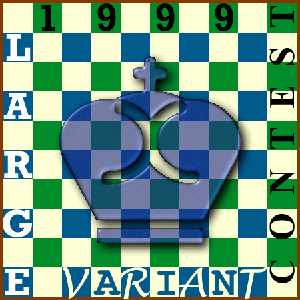Entry 20 -- King's Court
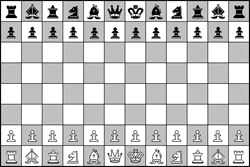 Sidney LeVasseur
Sidney LeVasseur
March 30, 1999
King's Court
This is an 8 x 12 oblong variant which features two new pieces, the Chancellor and the Jester. Castling rules have been adjusted for the wider board, and a special king's leap rule has been devised.
This game was invented by Sidney LeVasseur in 1997.
Entry 21 -- Vyrémorn Chess
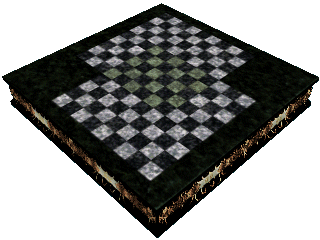 Charles Nathan McDonald
Charles Nathan McDonald
April 10, 1999
Vyrémorn Chess
Quote from the author:
Vyrémorn Chess is a fantasy chess variant designed with the relatively unique feature of being played
diagonally on a board of two overlapping square areas, using both new and traditional pieces.
There are 132 individual squares on the board, and each player starts with 33 pieces.
I have been working on a large chess variant for almost 12 years now,
methodically improving it based on suggestions and observations.
Entry 22 -- Round Table Chess
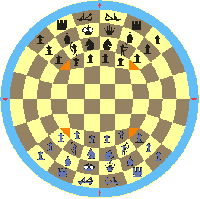 Richard VanDeventer
Richard VanDeventer
April 11, 1999
Round Table Chess
Quote from the author:
Round Table chess provides serious, traditional
chess players with another way to play chess when they feel a need
for a little variety or a change of pace. Beginners and Intermediate
chess players will also enjoy playing Round Table Chess, because it is
just as easy to learn and play as traditional chess.
All previous variations on the game of chess have either maintained a strictly rectangular or circular arrangement of the game pieces. Each has certain advantages over the other. The CirSquare game boards are the first to combine a circular chess board with a square chess board. Square/rectangular chess boards allow for only one primary direction (frontal) of attack on the opponent's home area. Circular boards usually allow for two directions (right and left sides) of attack. The CirSquare board provides three primary directions (right, left, and front) of attack.
Entry 23 -- Royal Court
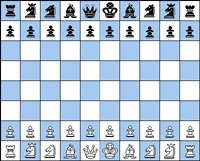 Sidney LeVasseur
Sidney LeVasseur
April 12, 1999
Royal Court
This is an 8x10 oblong variant, which features a pieces called the "Crowned Knight". This game uses the same rules as orthodox chess, except for the new piece and modified castling rule.
Entry 24 -- Divergent Chess
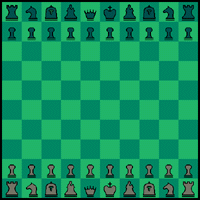 A.J. Winkelspecht
A.J. Winkelspecht
April 15, 1999
Divergent Chess
Quote from the author:
This chess variant was inspired by Michael Howe's Asymmetric Chess. It features a new piece called the Guard. All of the pieces move differently than they capture. All pieces can also be promoted upon reaching the last rank. There is a Zillions of Games rules file available for anyone who would like to play this game.
Entry 25 -- Mini Citadel Chess
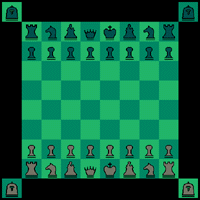 A.J. Winkelspecht
A.J. Winkelspecht
April 15, 1999
Mini Citadel Chess
Quote from the author:
This chess variant was inspired by a variant of Shantranj called Citadel Chess, or Shatranj al-husun. It features a new piece called the Guard, which is very weak. In fact, all of the other pieces are much weaker than their orthodox chess counterparts. But all pieces can also be promoted, all pieces have a special first move, and there are now two ways to win the game. There is a Zillions of Games rules file available for anyone who would like to play this game.
Entry 26 -- Flee!
April 15, 1999
Flee!
Quote from the author:
This variant is an attempt to demonstrate that a chess game with a stronger royal piece, given the right circumstances, can still be enjoyable. This piece will try to keep fleeing from enemy attacks, but should eventually fail.
Entry 27 -- Typhoon
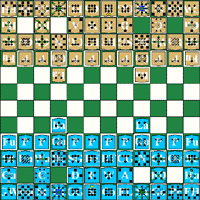 Adrian King
Adrian King
April 26, 1999
Typhoon
Quote from the author:
Shortly after I had submitted Scirocco, a 10 x 10 chess variant, to the contest to design large chess variants, I came down with a cold. Late one evening, after a long, overcaffeinated, slightly feverish day, a funny question popped into my brain: What if the inventor of Chu Shogi had based the game on Scirocco instead of (archaic) Shogi?
Entry 28 -- Round Table Chess II
April 22, 1999
Round Table Chess II
Quote from the author:
The CirSquare II game board was developed mainly for two players for Round Table Chess played with the Archers and Catapults or with 4 Knights and 4 Bishops per player. The board is has more squares-144 instead of 92. This gives more room to maneuver the additional chess pieces.
Entry 29 -- Quex
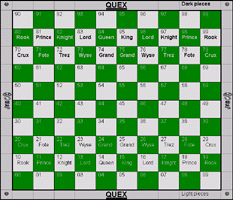 Soleste
Soleste
April 26, 1999
Quex
Quote from the author:
QUEX: This has gone back to the future, as it combines elements of ancient games, with the best of today's game, to create a unique futuristic concept. This is sublime. This is the future! Chaturanga and Shatranj were forerunners to the classic game of Chess. For centuries many have sought to make improvements on these games. There are now myriad's of variations, with every thing from Great chess to Shogi. Quex is a game that surpasses them all.
Entry 30 -- Bomberman Chess
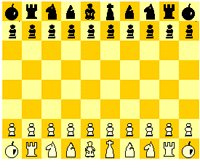 Bryan Lambert
Bryan Lambert
April 26, 1999
Bomberman Chess
Quote from the author:
Do you remember the old Bomberman games for NES (and the Super Bomberman games on Super NES)? Bomberman places a bomb on the ground, runs away, and the bomb explodes in both orthogonal directions to take out obstacles and baddies. Late one night, I began to ponder how to use this in a chess variant.I think I have my answer.
Entry 31 -- Napoleonic Chess
April 30, 1999
Napoleonic Chess
Quote from the author:
In designing Napoleonic Chess, I have attempted to remain true to the spirit of the Armies of the Napoleonic period, while maintaining some similarity to modern chess.
Entry 32 -- Keyles
April 30, 1999
Keyles
Quote from the author:
This excellent game requires a different strategy, being a much quicker and totally different type of game. Played with the same pieces and moves as Quex, there are two major differences. See the Quex pages for more information on the pieces and their moves.The objective in Keyles is to be the first player to move the King completely across the board, onto the opponent’s end zone or first rank, to win the game.
Entry 33 -- Big Outer Chess
April 30, 1999
Big Outer Chess
Quote from the author:
B.O. Chess is designed with two goals in mind. First, as with many large chess variants, B.O. Chess hopes to provide a spacious game. The second goal for B.O. Chess is to de-emphasize the center of the board by providing "outer" pieces which actually lose power when they move close to the center.
Entry 34 -- Scheherazade
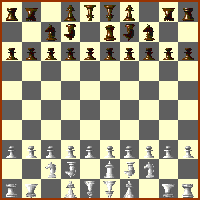 Robert Shimmin
Robert Shimmin
April 30, 1999
Scheherazade
Quote from the author:
Among the most frequently used variant chess pieces are the variant "queens," the chancellor (rook+knight) and cardinal (bishop+knight). It is well-known that each of these combinations is more valuable than the sum of its parts, at least partially due to the increased power and concentrated attacks of the combination piece. In Scheherazade, players begin with no queen-caliber pieces, but instead a variety of mid range pieces, and during the course of the game, may combine these pieces to choose their "queens."
Entry 35 -- Spiderball
April 30, 1999
Spiderball
Quote from the author:
The playing surface for SPIDERBALL is called the GAME GRID or the GLOBE. The SPIDERBALL game grid can perhaps be visualized as a "globe shaped spider web." It is modeled after the dodecahedron, which is a geometric solid with 12 flat surfaces. Each side of a dodecahedron is a pentagon (a 5 sided polygon). If there is a game store in your area which sells unusual shaped dice, look at a 12-sided die (you may even wish to buy one) and you will be looking at a dodecahedron.
Entry 36 -- Fantasy Grand Chess
April 30, 1999
Fantasy Grand Chess
Quote from the author:
Fantasy Grand Chess is a mix of Christian Freeling's Grand Chess and Ralph Betza's Chess with Different Armies, with a fantasy theme.All rules are as in Grand Chess, except that each player chooses a different army.
Armies choice is determined as in Chess with Different Armies. Secret/simultaneous choice may be considered the "official" method of selection.
Entry 37 -- Little Cheops
April 30, 1999
Little Cheops
Quote from the author:
Simply put, Cheops is a variant of chess, but here's how Frank Herbert put it in the Terminology of the Imperium section of Dune:"CHEOPS: pyramid chess; nine-level chess with the double object of putting your queen at the apex and the opponent's king in check."
Non-competing -- Jupiter
April 30, 1999
Jupiter
Quote from the author:
Jupiter is the third in a series of progressively larger games I have come up with. The first was Scirocco, a 10 x 10 chess variant, and the second was Typhoon, a 12 x 12 variant.Any reasonable person would stop after designing a game the size of Typhoon, in which each player starts off with 46 pieces, as in Chu Shogi. I find it hard to explain why I feel it necessary to inflict an even larger game on the world, except that I can. Perhaps you will accept the excuse that when I first saw "contest to design a large chess variant", I misunderstood it as "contest to design as large a chess variant as possible".
Non-competing -- Many Worlds Chess
April 22, 1999
Many Worlds Chess
Quote from the author:
Many Worlds Chess was inspired, in part, by the "many worlds" interpretation of quantum mechanics. Michael Clive Price has prepared a very nice although rather technical FAQ on this topic. Basically, the idea is that where an event whose outcome we would call "random" can occur, all possible outcomes actually do occur -- the universe effectively splits into a multitude of parallel universes, each representing one possible outcome of the event. The parallel universes do not communicate with each other further, which is why we aren't aware of having multiple selves.
Non-competing -- Bach Dang Chess
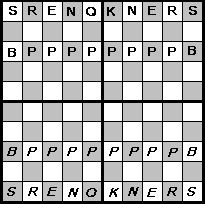 Vu Q. Vo
Vu Q. VoMarch 12, 1999
Bach Dang Chess
Quote from the author:
Bach Dang Chess (BDChess) is invented by Vu Q. Vo, which was started in July of 1992 and finally completed on March 10th, 1999. The game is named after the famous river, Song Bach Dang, where it has witnessed history rep eated itself. Essentially, BDChess is the bigger version of Quang Trung Chess . Most importantly, BDChess introduces a brand new piece, the craft. The craft could be sneaky like a submarine--out of nowhere it appear, or fast like an airplane--traverses great distance.
Non-competing Entry -- Xhess
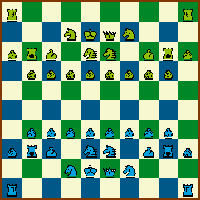
David Howe
January 13, 1999
Xhess
Quote from the author:
First off -- most of the ideas for this chess variant were borrowed from other games. Some from historical variants, some from newer variants. I've added what I think are a couple of (minor) new ideas to the game, but for those looking for something radically different from usual chess, this is not where you'll find it.I've tried to take a "minimalist" approach here -- trying to simplify the rules as much as possible, while still retaining complexity in game strategy and tactics. There is a Zillions of Games rules file available for anyone who would like to try out this game.
